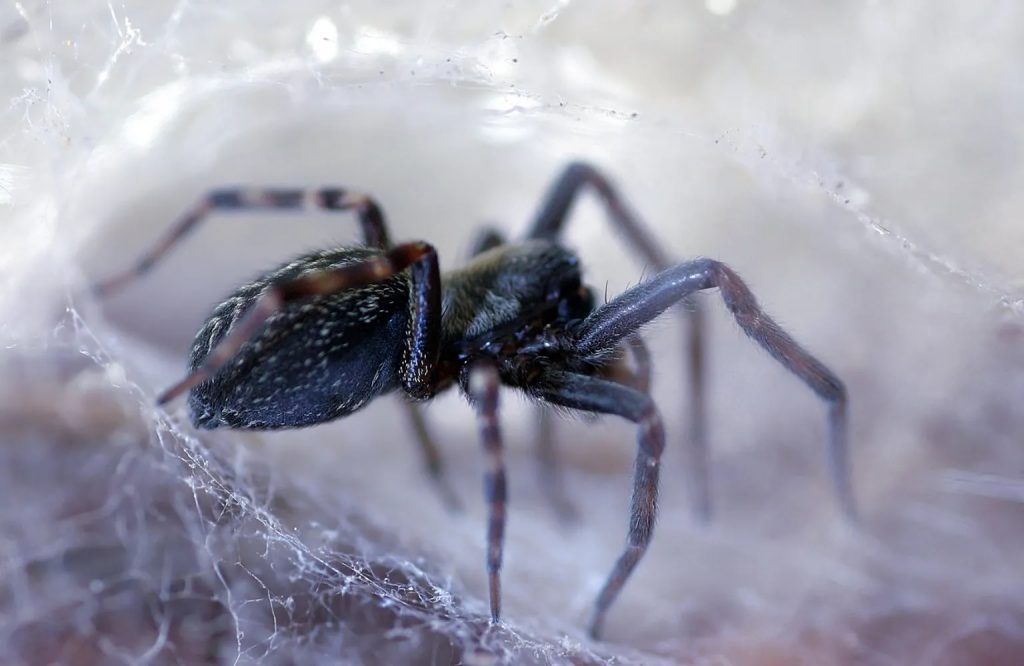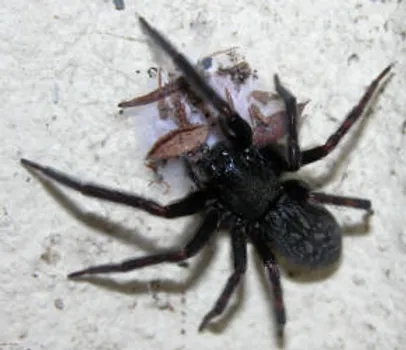INTRODUCTION: The Black House (or window) spider is found in most of Australia including Tasmania and has been introduced into New Zealand. It likes dry temperature and is more common inland. The Scientific name for the Black House spider is Badumna Insignis. The description of the Female is up to 18mm long and the Male is only 9mm. This spider has a strong build and is coal – black or dark brown. They also often have a row of faint white V’s on their back. The head -(Thorax) is shiny black and the eyes are in two rows of four. The Black House spider comes from the family Pesidae, it is a species of lace web-making spider.

HABITAT: The Black House Spider can be found in rock crevices on loose tree bark, sheds, cracks in brick walls and in window corners. They normally take up permanent residence in sheltered exterior corners of almost any wooden or brick structure. A favourite site is the corner of a window, the web radiating outwards. They can also found in cracks in fibro, rusting corrugated iron, ventilators and other places commonly visited by insects.

black house spider size
B. insignis is a dark-colored spider with the mature female about ¾ inch long with a 1 ¼ inch leg span. The males are smaller as their body is about 3/8 inch long. Both the males and females have dark brown legs and a gray abdomen with light markings on the top.
black house spider bite
Black house spiders are not aggressive and bites are infrequent. However, when bitten, the bite may cause pain and localized swelling. Occasionally other symptoms like nausea, vomiting, sweating and skin lesions are produced.
black house spider dangerous
Black house spiders are venomous but are not considered dangerous. They are timid and bites from them are infrequent. The bite may be excruciatingly painful and cause local swelling. Symptoms such as nausea, vomiting, sweating, and giddiness are occasionally recorded.
Help keep Spiderzrule going. Click to donate!
In the natural bush land. The Black House Spider often builds its snare in unhealthy trees. The web may appear tunnel like with one or more entrances. They are “typical” colourless, lacy, tangled, shawl-like structures. The web often has two or three funnel like entrances leading to a silky retreat where the spider rests in the daytime. The Black House Spider use the rakes on its hind legs to pull the silk from its spinning plate and spinnerets, When the web is first made it has a bluish tingle. The web consists of a series of radiating threads with zigzag threads crossing between them like the rungs of a ladder and are usually heavily embroidered. The Black House Spider can be found in dry areas throughout Australia and Tasmania.PREY: Black House Spider a wide variety of insects, and other spiders. If can be seen resting in a corner of it’s snare or in the retreat tunnel, with forelegs stretched out along the web. When the insect becomes tangled in the web and struggles the spider receives the vibrations through sensory hairs set in sockets on its forelegs. The spider grasps the threads of the snare with its claws and tugs sharply at rapid intervals in a reflex action produced by the female muscles. This tugging action entangles struggling insect, which is swathed in silk, bitten, dragged into the funnel and consumed in safety. It may eat the insect then or wrap it up with its silk thread for later.
BREEDING: A female Black House Spider wraps her eggs in a flat white silk egg sac. She hides the sac in her web or near a nearby crevice. The mother guards the sac until the spiderlings hatch. Each spiderling produces milk thread’s, which are caught by the wind and carry the young spiders away.

VENOM: The venom of the Black House Spider is poisonous but not lethal, it can cause much harm to humans. Bites are rare and usually occur when people attempt to move the web.
General Description
Cephalothorax (the fused head and thorax) black, rectangular at the front. Abdomen round and velvety black or dark grey. Body up to 2 cm long. Webs are lacy with funnels.
Biology
Black House Spiders are one of the more common species of spiders to be found in our homes and gardens. They like to make their lacy webs in the corners of window frames, or in brickwork, fences, tree bark and the like. The spiders make a funnel in their webs and wait at the back of this tunnel, where they cannot be seen by predators, for something to land in their web. When this happens, the spiders will rush out and bite the prey. The lucky Black House Spiders are those who make their webs near porch or outside lights on our homes. Insects which are attracted to the lights at night will often blunder into the webs, providing the spiders with a constant food source. These spiders do a very good job in keeping down insect numbers, provide a food source for birds and are one of the preferred food sources for White-tailed Spiders. They live for around two years. These spiders can be quite intimidating as they are often very dark in colour and will rush out of the funnel of their web to seize their prey.

Despite this, Black House Spiders are quite timid. Female spiders do not voluntarily leave their webs, but at certain times of the year the male Black House Spiders will go wandering looking for a female. The funnel shaped nature of the web leads some people to mistake them for funnel-web spiders, however funnel-web burrows are not built in window frames or fences and these spiders are not found in metropolitan Melbourne.
Black House Spider: The Common Australian Arachnid

Photo byClassicallyPrintedonPixabay
The Black House Spider, scientifically known asBadumna insignis, is a prevalent species of spider found in most regions of Australia. Despite its ominous name and appearance, this spider is relatively harmless to humans, although it can instill fear due to its frequent misidentification as the much more dangerous funnel-web spider. This article delves into the fascinating world of the Black House Spider, examining its size, characteristics, habitat, and behavior, as well as the implications of its bite and whether it poses any real danger to humans.
Physical Characteristics
The Black House Spider is a robust arachnid with a dark coloration, typically of a charcoal or black hue. The female spiders are larger than the males, with a body that can measure up to 18mm long, and a leg span reaching 30mm. The males, though smaller — with a body length of around 9mm — have a slim build with elongated legs. Both sexes exhibit a dark brown to black carapace and legs, while the abdomen is a charcoal grey adorned with a dorsal pattern of white markings.
Black House Spider Size: A Closer Look
The size of the Black House Spider can vary significantly between males and females. The females are particularly larger, with a body that can reach up to 18mm in length and a leg span of around 30mm. In contrast, the males are smaller, measuring approximately 9mm in body length. However, they possess longer legs in proportion to their body size, which gives them a distinctly different look from their female counterparts.

Habitat and Webs
Black House Spiders are versatile creatures that can adapt to various environments. They are commonly found in urban habitats, often making their homes in the nooks and crannies of our houses. They have a particular preference for window frames, doorways, vents, and under eaves — places that often attract their insect prey due to the presence of light.
In their natural environment, these spiders prefer to build their webs on rough-barked trees, logs, and rock wall crevices. Their webs are dense and have a distinctive ‘funnel-like’ shape, which is often misunderstood as a funnel-web spider web. These webs are more of a dense network of silk than actual sticky traps, designed to snag the spiny legs of insects.
Diet and Predation
Black House Spiders are known for their effective hunting strategies. They feed on a wide variety of insects, including flies, beetles, ants, moths, and mosquitoes. These spiders take full advantage of the allure of light sources in attracting their prey. As such, they are often found around lamps, windows, and other sources of light, where their unsuspecting prey congregates.
Interestingly, Black House Spiders themselves also have natural predators. These include White-tailed spiders, parasitic wasps, and flies. This fascinating circle of life plays out right in our homes and backyards, often unbeknownst to us.
Mating and Reproduction
The mating process of the Black House Spider is a fascinating spectacle. Males, upon reaching sexual maturity, leave their webs in search of females. They attract the female’s attention by plucking the strands of her web. Once the male is confident of the female’s receptiveness, he approaches her and inseminates her with his palps.
Post-mating, the female constructs several white silk egg sacs, securing them within the web retreat. Unlike many other spider species, the female Black House Spider stays with her eggs until they hatch. Upon hatching, the spiderlings disperse, marking the beginning of their own life cycle.

The Black House Spider Bite
Despite their somewhat intimidating appearance, Black House Spiders are not naturally aggressive creatures. They usually retreat into their web when disturbed, only coming out to capture prey. However, if threatened, they can bite, and their venom can cause certain symptoms in humans.
A Black House Spider bite can result in localized swelling and pain. In some cases, it might also cause nausea, vomiting, sweating, and giddiness. Although the bite is seldom life-threatening, it can be quite painful and lead to discomfort. However, it is crucial to note that these spiders are often mistaken for the far more dangerous funnel-web spiders, which necessitate a completely different first-aid response.
Is The Black House Spider Dangerous?
Despite the fear associated with them, Black House Spiders are not considered dangerous to humans. Their bite, while painful, is typically non-lethal and only causes temporary discomfort. They are non-aggressive spiders that usually only bite when provoked or accidentally disturbed.
However, the presence of these spiders in homes can be a nuisance due to their unsightly, dense webs. Moreover, frequent misidentification as the more venomous funnel-web spider often leads to unnecessary panic.
The Black House Spider is an integral part of the Australian ecosystem, playing a vital role in controlling insect populations. While their appearance and the occasional painful bite might cause discomfort, they are not a threat to humans. Understanding more about these creatures can help in fostering respect rather than fear, allowing us to coexist peacefully with these fascinating arachnids.
